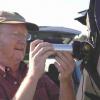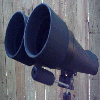
What's Up Lepus
#1

Posted 04 January 2008 - 06:38 AM
#2

Posted 04 January 2008 - 11:39 AM
Terry
#3

Posted 05 January 2008 - 01:45 AM
Thanks for adding that in, I have not looked at it in a while, I may give it a try.
Thanks;
Steve Coe
#4

Posted 05 January 2008 - 04:50 PM
#5

Posted 05 January 2008 - 06:58 PM
Well for the second year in a row, I'll be searching for Hinds Crimson star!!
Worth the search! As described in Burham's, it really does look like a drop of blood against the sky.
#6

Posted 05 January 2008 - 07:34 PM
If you have some aperture to throw at it--IC418 (The Raspberry) is a fun planetary nebby. At about 200X, it's a tiny, thin, PINK ring surrounding an obvious central star. The pink color becomes pretty easy around 14-inches of aperture. But it's really small, so look close!
#7

Posted 05 January 2008 - 09:50 PM
#8

Posted 06 January 2008 - 08:10 AM
The deepest part of minima only lasts about a month. R Leporis could easily be 1 or 2 magnitudes brighter now, or a month or two after minima. You should be able to see it with 8-inches of aperture through minima--but the last minima I observed in a C8 wasn't as colorful as the view in a larger aperture.
Also, the minima date I provided earlier was extrapolated from the chart provided in the url above, so at best it's an estimate. A few minima dates from years past are available online, but they don't seem to agree with the AAVSO data. So--for the record--minima should occur sometime around late February/early March this year.
#9

Posted 06 January 2008 - 12:25 PM
It will definitely be worth a follow up with the telescopes sometime. My Bright Star Atlas only shows an unannotated double star symbol here. My old version of Megastar doesn't display the NGC number or OC symbol but will find it if you search on the NGC number. U2000 shows it as an NGC cluster.
Dave
#10

Posted 06 January 2008 - 12:59 PM
Informative article. A unique (as far as I can find out) deep sky object that is rarely mentioned when discussing Lepus is h 3780, also known as NGC 2017. This is a multiple star system that is easily viewed with smaller backyard telescopes. I can see 5 of the 6 stars with 50X in my 8-in newtonian. This is a charming little system that was originally thought to be a very small open star cluster. It is also easy to find as it lies about 7 arc minutes east of alpha Leporis. Try it, you'll like it!
Terry
There's a so-so image of NGC 2017 that I took through the ASH 17" f/15 classical Cassegrain posted at http://www.cloudynig....php?photo=2714
Dave Mitsky
#11

Posted 07 January 2008 - 04:49 AM
I hope that you do get a chance to see R Lep soon. I do love red stars and it is a favorite.
Enjoy;
Steve Coe
#12

Posted 08 January 2008 - 12:55 AM
#13

Posted 08 January 2008 - 01:34 AM
#14

Posted 08 January 2008 - 04:31 AM
The short answer is "I don't know why Vic and I would have differences in the color seen in this planetary".
Colors in any deep sky object is very subtle. Our vision was not made to see color at those low light levels. But, they do appear "real" within our heads and now it becomes a psychology dicussion that makes it difficult to say anything other than "that is what I saw".
I will certainly leave IC 418 on my observing list and see if I do see anything other than pale green or grey in any future observing session.
Clear Skies to us all;
Steve Coe
#15

Posted 11 January 2008 - 02:47 AM
Hello, Steve (the author) talks of a:"very nice greenish glow around the central star", Vic talks of:"thin pink ring around central star"/Viccalls it 'the rasberry'. Both regarding IC418 planetary. I can't wait to get my scope out this weekend for visiting with Lepus. For now please some thoughts on this large difference in 'the color' about IC418 between these two seasoned observers, both with midsized aperture, Steve from I'd guess 'good skies'. thanx, charlie...150mmf/5 SkyWatcher achro, 127mm f/8 apo-triplet, 100x25 Zhumell binocs(now on better fork mount!)
I've seen IC 418's "raspberry" colored annulus a number of times, but only through large unfiltered apertures under very good conditions. (The first time I experienced it was through a 25-inch Dob at the Winter Star Party.) Otherwise, it hasn't exhibited that exceptional hue, even through 18 and 20-inch apertures.
Dave Mitsky
#16

Posted 11 January 2008 - 07:05 AM
What kind of filter? I've only been able to see the pink coloration unfiltered. A few years back at the WSP I was observing IC418 (about 200X in a 22-inch f/4 Dob) with Barbara Wilson and she commented that it was the most vivid color she had seen in any nebula. I told her I thought that the Ghost of Jupiter was considerably more colorful (violet and chartreuse), but I don't think she had really studied the nebula at RFT magnifications.I've seen IC 418's "raspberry" colored annulus a number of times, but only through large filtered apertures under very good conditions...
The coloration in IC418 does handle magnification better. And it is higher from Florida (and the Florida Keys) than most other parts of the contiguous US. But the pink color (although it's a thin line) is always obvious (at least to me and my observing friends) in Dick Denison's 14 StarMaster.
#17

Posted 11 January 2008 - 07:57 AM
My post should have read "unfiltered apertures". I made the correction.
A report that I made some years ago on IC 418 is posted at http://www.visualdee...s/msg02065.html
Dave Mitsky
#18

Posted 13 January 2008 - 12:10 AM
#19

Posted 13 January 2008 - 04:46 PM
Enjoy;
Steve Coe
#20

Posted 20 January 2008 - 03:01 AM
Once again you have provided many of us with new objects in which to search for (and observe) with your very well written article. Thank you for your time and effort for putting these together!
WadeVC
#21

Posted 20 January 2008 - 04:20 AM
You are very welcome, it is always great to hear from a satisfied "customer". I had a request to provide these as pdf files, but I don't have a program that will do that and Allister said that it is not necessary. I give permission for someone to use the online files and make them into pdf's if someone thinks that would be more useful.
Clear Skies;
Steve Coe
#22

Posted 20 January 2008 - 12:07 PM
In a 25x100 binocular, on a very good night, it is scarcely visible as an averted-vision ghost. It's very tiny and is seen only as a subtle variation in the background brightness of the sky. Tapping the tubes was necessary to confirm it.
In my 6" Mak-Cass, it's visible in direct vision, but only as a faint and small spot against the background. Throwing magnfication at it only caused it to thin out and vanish.
It's no show-stopper.
I have yet to glimpse Hind's star, but I'll keep looking.
How does the color compare to Herschel's Garnet Star?
#23

Posted 20 January 2008 - 01:04 PM
Herschels Garnet Star (Mu Cephi) is brighter and not as red. In my opinion, closer comparisons to R Leporis are V Aquila, V Hydra, and T Lyra.I have yet to glimpse Hind's star, but I'll keep looking.
How does the color compare to Herschel's Garnet Star?
See:
http://www.astropix....LIST/CARBON.HTM
http://en.wikipedia.org/wiki/R_Leporis
http://en.wikipedia.org/wiki/Mu_Cephei
#24

Posted 20 January 2008 - 02:24 PM
According to Brian Skiff at Lowell Observatory, V Hydrae is the reddest star in the sky. If I remember correctly it is the only star with a B-V value of greater than 5. It is "underneath" Leo, so give it a try in the Spring.
They are fun;
Steve Coe
#25

Posted 20 January 2008 - 03:52 PM
The link I posted earlier, "The Top 10 Very Red Stars", notes three Skiff B-V 5.5 stars (and one 5.8!) I pulled the old May '98 S&T to reread some of Brian's commentary. He mentions that V Hydrae may be making the transition from red-giant to a planetary nebula! Like you, I've followed several of my favorite carbon stars for many years. I like to include them when doing outreach at schools and at other public venues because they always seem to generate real excitement at the eyepiece....According to Brian Skiff at Lowell Observatory, V Hydrae is the reddest star in the sky. If I remember correctly it is the only star with a B-V value of greater than 5.
Yes they are!They are fun
























